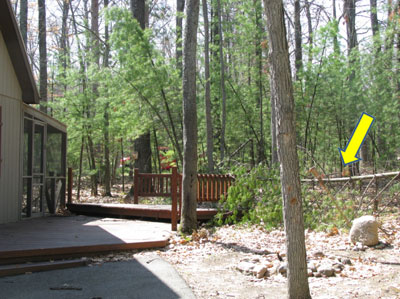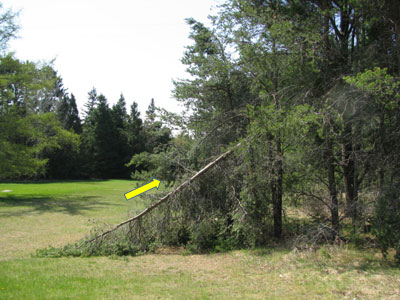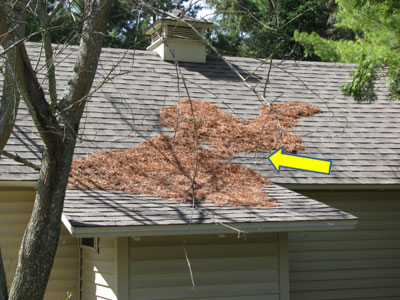Northern Michigan cottage owners can protect their property from wildfire damage
Property owners should take time to survey their buildings and grounds to make them more wildfire resistant.
Though this is something that should be done every year, several large storms that passed through northern Michigan this past winter caused more widespread damage than usual to trees in some areas – especially conifers. In some locations, this has caused a lot of branches, needles and other debris to accumulate on the ground, become lodged in trees or gather on top of the roofs of cottages and outbuildings. All of these situations pose a wildfire risk to personal property (see Photo #1).
The Michigan State University Firewise program offers homeowners the following landscaping tips on wildfire safety for their cottages. The goal is to keep the landscape around your cottage “lean, green and clean.” By following these steps, cottage owners can reduce their vulnerability from the threat of wildfire.
- Keep the area around your cottage well-irrigated and free from dry vegetation and debris. Mow the lawn or open space around your cottage regularly, and remove any weeds and other unwanted vegetation that grows up against the walls of the buildings. This will help keep ground fires from spreading toward your cottage.
- Prune all trees so that the lowest limbs are 6 to 10 feet from the ground. Be especially alert for any broken branches that are leaning against the ground that can provide a ladder for wildfire flames to climb up into the tree crowns. Wildfires that progress into the crowns of trees create more difficult to control and allow fires to spread more quickly (see Photo #2).
- Remove dried leaves, pine needles, broken twigs and other dead vegetation from rooftops and gutters. Pay special attention to valleys created where two sloping sides of a roof come together. These areas are natural concentration points for windblown debris. This practice is critical to keep windblown embers from nearby wildfires starting a new fire or “hotspot” on your property (see Photo #3).
- Within 3 to 5 feet of the home, use nonflammable landscaping materials such as rock, pavers, pea stone and other types of gravel, annuals and high-moisture perennial plants. This creates a natural firebreak that can keep flames from reaching the walls of your cottage.
- In the event of a wildfire, access to your property by fire-fighting equipment is critical. Driveways, two-track trails, bridges and culverts leading into private property need to be able to accommodate the height of large firetrucks. Most emergency vehicles require road clearance of 12 feet wide and 15 feet high.
- Keep firewood stacks and propane tanks at least 30 feet from the walls of a building. Obviously, firewood is flammable and should not be stored right up against the side of a building. Liquid fuel from propane tanks is flammable if it escapes (i.e., the pressure valve malfunctions), so creating distance between your cottage and propane tank is a wise practice.
For more information on protecting your home from wildfire, visit the National Firewise Web site. Additionally, Michigan residents can also purchase “Protecting Your Michigan Home from Wildfire” (Extension bulletin E2831) from the online Michigan State University Bookstore.

This white pine, broken from recent storms, came
to rest right on top of this outdoor deck railing creating a
serious fire hazard to this cottage. Also notice the bent
over pine trees in the background that also suffered damage
and are leaning towards the house, which adds to the fire risk.

Storm damage caused by heavy snow and strong
winds this past winter. This leaning stem would provide
wildfire with a perfect “ladder” for flames to burn up into
the crown of these trees, causing a more serious fire situation.

When needles, leaves, dead twigs and other debris are
allowed to collect on roof tops, it creates another fire hazard
to private property. Wind-blown embers and fire-brands
from nearby wildfires can ignite this debris and cause houses
and outbuildings to catch fire and burn.



 Print
Print Email
Email


